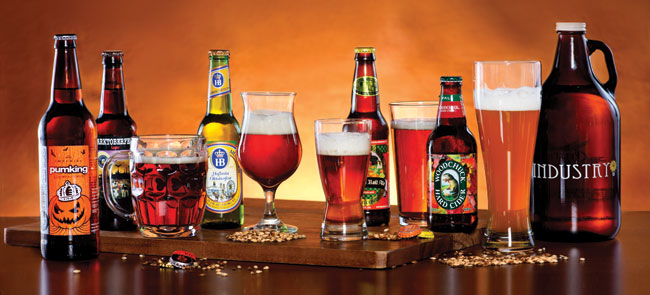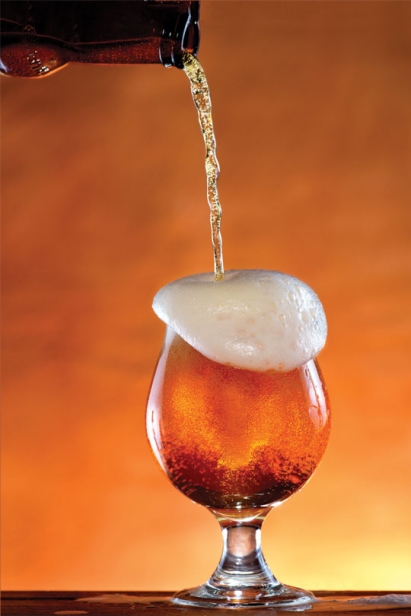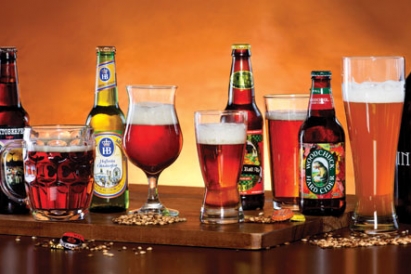‘Tis the Seasonals
Crisp leaves of auburn and gold are slowly beginning to color the sidewalks. Our favorite chefs have stopped grilling and begun roasting. Gone are the dog days of summer, and with them: outdoor patios, smoky barbecues, and beer menus laden with classically lighter styles. It’s inevitable — autumn is a season of change, especially in the world of craft brewing. So, bid farewell to citrus-noted pilsners, pale ales, and shandies, and embrace the rich flavors of fall’s seasonal brews. We’ve poured the knowledge of local experts and beer enthusiasts into the next three pages to help you do just that. Now, hop to it!
breaking it down
Browse the craft beer selection at your favorite restaurant, brewery, or distributor, and you’ll notice that the brews, they are a-changin’. A true seasonal beer is released once annually, coinciding with the agricultural offerings available only during that specific time of year. As autumn is often synonymous with harvest, seasonal fall beers tend to comprise ingredients that are traditionally harvested during this time of year. So, what distinguishes an autumn beer from the rest? “[In autumn] people tend to think of pumpkin as the only [seasonal beer] flavor,” explains Justin “Hootie” Blakey, “executive director of the nectar” at D’s Six Pax and Dogz. Due to high demand, pumpkin plays a leading role on the seasonal shelf in D’s Beer Cave, but it is certainly not alone. Hootie, who has been the Regent Square staple’s resident beer master for nearly 12 years, breaks down fall seasonals into three main categories: pumpkin beers, Oktoberfest brews, and harvest ales.
PUMPKIN
Not all pumpkin beers are created equally. While some brewers prefer to use pumpkin spices or purée in the mash, others opt for the real deal, adding bits of freshly harvested pumpkin. In response to his customers’ requests for a pumpkin beer, East End Brewing Company founder Scott Smith devised the cleverly named “Nunkin”— a pumpkin-style beer he says “tastes like pumpkin spices, but not pumpkin” — which will be distributed both at the brewery and at various bars and restaurants in Western Pennsylvania this fall.
Brewing preferences aside, pumpkin beers are gaining popularity across the board, hailing as “the season’s most popular beers,” according to Olivier Kielwasser, senior director of beer, wine, and spirits at Giant Eagle. “Southern Tier’s Pumking will be the [fall] favorite this year,” predicts Kielwasser, and with solid reasoning. With notes of caramel, nutmeg, and clove, the Pumking is difficult to resist — especially at Lawrenceville’s Industry Public House, where it’s one of several fall seasonals offered. “As many establishments do, we add cinnamon and brown sugar around the rim of each glass to accentuate the Pumking’s sweetness,” says manager Adam Pribila.
If an extra-sweet pumpkin brew isn’t your style, though, you can elect to suit your senses with a less overwhelming “ale tail” — a crafty mixture of beer and another beverage, preferably one that’s non-alcoholic — as served at Bocktown Beer and Grill. Founder Chris Dilla expects to serve several pumpkin and cider ale tails this autumn, dubbing seasonal pumpkin beers “the belles of the ball.” For added zest, Dilla incorporates a dash of flavored liquor to ale tails when appropriate. “Whipped cream vodka in a pumpkin ale tail creates a pumpkin pie flavor,” she says.
Our favorites: Penn Brewery’s Pumpkin Roll Ale; Erie Brewing’s Johnny Rails Pumpkin Ale; New Holland’s Ichabod Pumpkin Ale
Pair them with: Roasted chicken or turkey; pumpkin pie
OKTOBERFEST
Originating in Germany, the rich, toasty lagers we recognize as Oktoberfests are traditionally brewed in March and contained in a cellar for approximately six months afterward — although a common misconception is that they’re only fresh during the month of October. “Oktoberfests aren’t old in November,” Hootie explains. “They’re good from the end of summer through Thanksgiving, and sometimes, even beyond that.” The Oktoberfest, or Märzen (“March” in German), is generally described as a full-bodied lager with subtle hints of spice.
Of course, the Oktoberfest beers we drink in America are a bit different than the ones found in Germany. Alas, unless a European getaway is in your foreseeable future, authenticity may be difficult to come by. We recommend Hofbräuhaus Pittsburgh’s Oktoberfest — it closely resembles Germany’s Oktoberfest, without overwhelming the palette.
Locally, most of the Oktoberfest styles available are brewed with added spices and flavoring, such as Great Lakes’ Oktoberfest, which flirts with toffee and caramel. “It’s my favorite,” notes Pribila, “because it’s not focused on nutmeg or cinnamon or allspice [like others of its kind].”
Our favorites: The Church Brew Works’ Oktoberfest German-Style Lager; Leinenkugel’s Oktoberfest German-Style Märzen; Erdinger’s Oktoberfest
Pair them with: Bratwurst, kielbasa, sauerkraut, or bier cheese
Thirsty Dog Brewing Company Barktoberfest Lager — Bocktown Beer and Grill
Samuel Adams Octoberfest Lager — Giant Eagle Market District
Hofbräu Oktoberfest — Giant Eagle Market District
The Church Brew Works Oktoberfest German-Style Lager — Giant Eagle Market District
Leinenkugel’s Oktoberfest German-Style Märzen — Giant Eagle Market District
Penn Brewery Pumpkin Roll Ale — D’s Six Pax and Dogz
Erie Brewing Company Johnny Rails Pumpkin Ale — Bocktown Beer and Grill
Woodchuck Fall Hard Cider — Giant Eagle Market District
The Traveler Beer Co. Tenacious Traveler Shandy — Giant Eagle Market District
Growler — Industry Public House
HARVEST ALE
‘Tis the season for hops — the fragile, cone-like flowers responsible for the distinct bitterness most commonly associated with India Pale Ales (IPAs). Picked in August and September, fresh hops have an incredibly short shelf life and must be used almost immediately upon harvest. East End Brewing’s Big Hop Harvest Ale is a “true seasonal beer because it’s brewed with fresh, un-dried, wet hops,” says Smith.
When hops endure a drying process, Smith says, they become shelf-stable. However, just as your food should be fresh and preservative-free, so should your hops. “Authentic harvest ales will have fresh, local ingredients picked within 24 hours to a week,” adds Hootie.
Prefer your harvest ales extra heavy on the hops? You’re in luck — Smith offers a unique feature to customers who fill their growlers at East End. “We stuff hops into the top of the growler for added flavor,” he reveals. While the appearance of leafy nuggets floating at your beer’s brim may be initially off-putting, Smith believes that using ingredients as visual aids may help people to understand craft beer’s artisan nature. “[Craft brewing] isn’t just a commodity,” he explains. “It’s food.”
Says Dilla, “Fall is a really good time for East End Brewing’s Big Hop Harvest.” And, having sampled the ale directly at the brewery itself, we agree.
Our favorite: East End Brewing’s Big Hop Harvest Ale
Pair it with: Anything spicy! “Spicy food really works here. Your beer will taste hoppy-er, and your food will taste spicier,” says Smith.
By Lauren Wells / Photographed by Cayla Zahoran / Art Direction by Jason Solak







